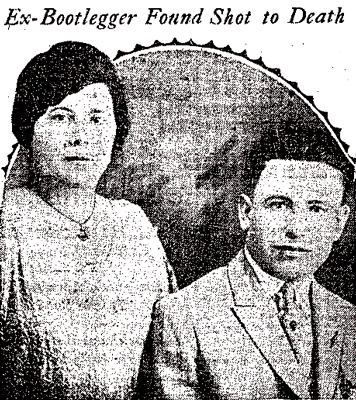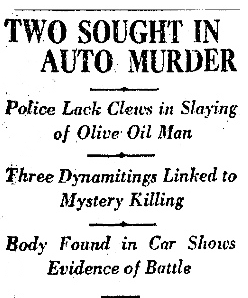April 2, 1927
Los Angeles
 On this Spring day in 1927, investigating officers were pavement-pounding in the Italian neighborhoods, attempting to scare up information about the April Fool’s Day discovery of one murdered Antonio (Tony) Ferraro. But there was no talking to be had, and the crime scene revealed nothing in the way of tell-tale fingerprints or any such evidence, and so Tony Ferraro remains another unsolved Los Angeles gangland slaying.
On this Spring day in 1927, investigating officers were pavement-pounding in the Italian neighborhoods, attempting to scare up information about the April Fool’s Day discovery of one murdered Antonio (Tony) Ferraro. But there was no talking to be had, and the crime scene revealed nothing in the way of tell-tale fingerprints or any such evidence, and so Tony Ferraro remains another unsolved Los Angeles gangland slaying.
Tony Ferraro was 34, married, and an erstwhile bootlegger. He had given up the bootlegging game back in January when officers knocked out his elaborate still at 532 South Soto St. Thereafter he had gone into the olive oil business–the evening of March 31 he set out from his home at 2724 Cincinnati St. with six one-gallon cans of the unctuous stuff (only to return for his funeral a week later). On the morning of April 1 a passerby’s attention was attracted by the stream of blood pouring forth from the back seat of Ferraro’s Studebaker, parked at 659 Kohler St.
 Robbery was not the motive, as Ferraro’s diamond ring, watch, money clip and olive oil were unmolested. Persons unknown entered Ferraro’s car, where he was beaten with a tire iron (his bruised hands indicating he put up a strong fight) and then shot in the head once with a .38 and twice with a .32. The body was then pulled from the front seat and lain across the olive oil in the back.
Robbery was not the motive, as Ferraro’s diamond ring, watch, money clip and olive oil were unmolested. Persons unknown entered Ferraro’s car, where he was beaten with a tire iron (his bruised hands indicating he put up a strong fight) and then shot in the head once with a .38 and twice with a .32. The body was then pulled from the front seat and lain across the olive oil in the back.
Ferraro was a Matranga relative and Los Angeles bootlegger who had had some problems with his business partners. In September of 1925, someone dynamited a vacant two-story building Ferraro owned at 2729 North Main; eight months later the home of his cousin, Victor Pepitone, 317 West 77th St., was dynamited; five months thereafter the home of Jim Mussacci, Ferraro’s business partner, 675 Lamar St., was destroyed in a dynamite explosion. The news from April 2 hints that Ferraro may have recently talked to authorities and implicated two former liquor trade associates, resulting in their arrest, but that clue went nowhere. Attempts to quiz the widow Constance resulted in her continued protestations that Tony had no enemies anywhere.
 On April 5 the Times reported a rumor that Ferraro’s car had been seen the night of the 31st in Chinatown between when he set off from home at 6 p.m. and when the car was first spotted at 10 p.m. at Sixth and Kohler, but placing the killing in Chinatown didn’t make solving the murder any more possible or probable. That day Ferraro was released from the Coroner’s to his home once more; the cinematic mind must imagine properly florid gangland sendoff, with bouquets from those Wright Act violators Tony double-crossed.
On April 5 the Times reported a rumor that Ferraro’s car had been seen the night of the 31st in Chinatown between when he set off from home at 6 p.m. and when the car was first spotted at 10 p.m. at Sixth and Kohler, but placing the killing in Chinatown didn’t make solving the murder any more possible or probable. That day Ferraro was released from the Coroner’s to his home once more; the cinematic mind must imagine properly florid gangland sendoff, with bouquets from those Wright Act violators Tony double-crossed.
And up in heaven, the special cloud reserved for unsolved LA homicide victims—Harry Katz there waiting with a martini—added one more.




 On this Spring day in 1927, investigating officers were pavement-pounding in the Italian neighborhoods, attempting to scare up information about the April Fool’s Day discovery of one murdered Antonio (Tony) Ferraro. But there was no talking to be had, and the crime scene revealed nothing in the way of tell-tale fingerprints or any such evidence, and so Tony Ferraro remains another unsolved Los Angeles gangland slaying.
On this Spring day in 1927, investigating officers were pavement-pounding in the Italian neighborhoods, attempting to scare up information about the April Fool’s Day discovery of one murdered Antonio (Tony) Ferraro. But there was no talking to be had, and the crime scene revealed nothing in the way of tell-tale fingerprints or any such evidence, and so Tony Ferraro remains another unsolved Los Angeles gangland slaying. Robbery was not the motive, as Ferraro’s diamond ring, watch, money clip and olive oil were unmolested. Persons unknown entered Ferraro’s car, where he was beaten with a tire iron (his bruised hands indicating he put up a strong fight) and then shot in the head once with a .38 and twice with a .32. The body was then pulled from the front seat and lain across the olive oil in the back.
Robbery was not the motive, as Ferraro’s diamond ring, watch, money clip and olive oil were unmolested. Persons unknown entered Ferraro’s car, where he was beaten with a tire iron (his bruised hands indicating he put up a strong fight) and then shot in the head once with a .38 and twice with a .32. The body was then pulled from the front seat and lain across the olive oil in the back. On April 5 the Times reported a rumor that Ferraro’s car had been seen the night of the 31st in
On April 5 the Times reported a rumor that Ferraro’s car had been seen the night of the 31st in 





